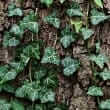Background
- English ivy (Hedera helix) is native to most of Europe and southwest Asia. Although it is often used as a landscaping groundcover in the United States, it is also an invasive species that is considered a noxious weed in some areas.
- Based on preliminary animal studies, English ivy leaf extract may have antimutagenic (anticancer) and antioxidant properties. In addition, it may also be beneficial for children with asthma or adults with chronic obstructive pulmonary disease. However, more research is needed in all of these areas to assess English ivy's potential benefits.
References
Natural Standard developed the above evidence-based information based on a thorough systematic review of the available scientific articles. For comprehensive information about alternative and complementary therapies on the professional level, go to . Selected references are listed below.
- Amara-Mokrane YA, Lehucher-Michel MP, Balansard G, et al. Protective effects of alpha-hederin, chlorophyllin and ascorbic acid towards the induction of micronuclei by doxorubicin in cultured human lymphocytes. Mutagenesis 1996;11(2):161-167.
View Abstract - Billington T, Pharmawati M, Gehring CA. Isolation and immunoaffinity purification of biologically active plant natriuretic peptide. Biochem Biophys Res Commun 6-27-1997;235(3):722-725.
View Abstract - Gaillard Y, Blaise P, Darre A, et al. An unusual case of death: suffocation caused by leaves of common ivy (Hedera helix). Detection of hederacoside C, alpha-hederin, and hederagenin by LC-EI/MS-MS. J Anal Toxicol 2003;27(4):257-262.
View Abstract - Garcia M, Fernandez E, Navarro JA, et al. Allergic contact dermatitis from Hedera helix L. Contact Dermatitis 1995;33(2):133-134.
View Abstract - Gulcin I, Mshvildadze V, Gepdiremen A, et al. Antioxidant activity of saponins isolated from ivy: alpha-hederin, hederasaponin-C, hederacolchiside-E and hederacolchiside-F. Planta Med 2004;70(6):561-563.
View Abstract - Guo R, Pittler MH, Ernst E. Herbal medicines for the treatment of COPD: a systematic review. Eur Respir J 2006;28(2):330-338.
View Abstract - Hofmann D, Hecker M, Volp A. Efficacy of dry extract of ivy leaves in children with bronchial asthma--a review of randomized controlled trials. Phytomedicine 2003;10(2-3):213-220.
View Abstract - Johnke H, Bjarnason B. [Contact dermatitis allergy to common ivy (Hedera helix L.)]. Ugeskr Laeger 6-20-1994;156(25):3778-3779.
View Abstract - Jors E. [The prevalence of skin and mucosal symptoms in gardeners handling Ficus benjamina (weeping fig) and Hedera helix (ivy). A cross-sectional study]. Ugeskr Laeger 9-8-2003;165(37):3526-3529.
View Abstract - Massmanian A, Valcuende Cavero F, Ramirez Bosca A, et al. Contact dermatitis from variegated ivy (Hedera helix subsp. canariensis Willd.). Contact Dermatitis 1988;18(4):247-248.
View Abstract - Oka K, Saito F, Yasuhara T, et al. The allergens of Dendropanax trifidus Makino and Fatsia japonica Decne. et Planch. and evaluation of cross-reactions with other plants of the Araliaceae family. Contact Dermatitis 1999;40(4):209-213.
View Abstract - Ozdemir C, Schneider LA, Hinrichs R, et al. [Allergic contact dermatitis to common ivy (Hedera helix L.)]. Hautarzt 2003;54(10):966-969.
View Abstract - Taylor P. Healthy household hints. STEP Perspect 1999;99(3):16.
View Abstract - Villani P, Orsiere T, Sari-Minodier I, et al. [In vitro study of the antimutagenic activity of alphahederin]. Ann Biol Clin (Paris) 2001;59(3):285-289.
View Abstract - Yesudian PD, Franks A. Contact dermatitis from Hedera helix in a husband and wife. Contact Dermatitis 2002;46(2):125-126.
View Abstract







